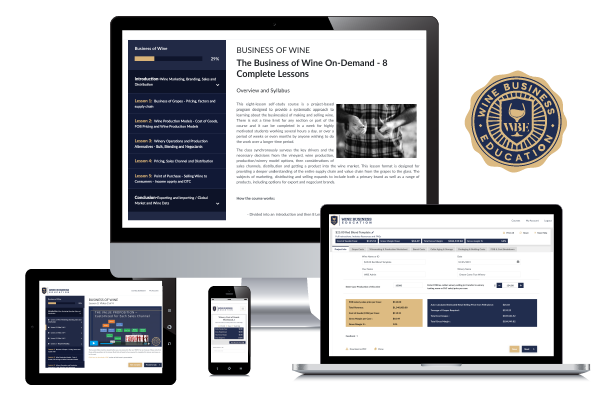
Business of Wine Course Plus Annual License of WBE Workbooks
$599.00
Always-on 24×7 web-based course. Work at your own pace directly from this site! This eight lesson self-study course is a project-based program designed to provide a systematic approach to learning about the business(es) of making and selling wine.
Overview and Syllabus
The class synchronously surveys the key drivers and the necessary decisions from the vineyard, wine production, production/winery model options, then considerations of sales channels, distribution and getting a product into the wine market. This lesson format is designed for providing a deeper understanding of the entire supply chain and value chain from the grapes to the glass. The subjects of marketing, distributing and selling expands to include both a primary brand as well as a range of products, including options for export and negociant brands.
How the course works:
- Divided into an introduction and then 8 Lessons
- Each Lesson consists of a series of tasks: watch the video lecture, required reading, Wine Business Education financial calculator assignments, and then a simple Lesson quiz
- You must complete each task to move on the next task, then you can move on to the next Lesson when you have successfully completed the Lesson Quiz.
OPTIONAL: Directions and resources for an optional wine blending exercise, complete with instructions on how to use the Blending Cost of Goods Calculator workbook (separate from the general Cost of Goods Calculator) for a bulk/blended wine project (versus traditional processing of grapes), is included in the program.
Wine Busines Education Financial Calculators:
Each lesson makes use of our proprietary Wine Business Education financial calculators to provide a realistic perspective of the costs associated with vineyard operations, cost of grapes, production, packaging, distribution, sales, marketing and running a tasting room or retail operation. These workbooks are very detailed and can be used an educational tool, to run actual financials, or for forecasting purposes. As you are going through the coursework keep in mind that most wine education focuses on the 'aesthetics' of certain decisions and this course focuses on the supply chain (order in which things occur in the growing, making and selling of wine) and the value chain (what decisions are made that create a sense of worth to the product through the supply chain).
When you encounter certain practices, treatments or any element that you do not understand take time to research and learn more by conducting a simple internet search on the topic. You may be amazed how effective this is for concurrently increasing your overall knowledge of the source of wine qualities, and wine terminology.
NOTE: There is no course text per se. Reading assignments will be a combination of published papers, and news/hot topic articles that pertain to each lesson segment. Additionally you will be asked to view additional videos and conduct simple activities that can be accomplished when shopping at stores (grocery stores, wine stores), winery visits (when/if possible) and dining in restaurants. These activities have you look at wine product selections, pricing and details you would not normally consider asking yourself, "how did this get here, what is the market for this wine, and how much did it cost to produce it?" Also strive to discuss the wine business, not your usual wine aesthetic discussions, with anyone and everyone you run into! There is not a time limit for any section or part of the course and it can be completed in a week for highly motivated students working several hours a day, or over a period of weeks or even months by anyone wishing to do the work over a longer time period.
Course Goals
Through a combination of video lectures, project-based learning, selected reading and optional activities, students will be able to:
- Understand the contribution of the individual components (grapes, production, cellaring, and packaging) to the potential cost and value of a wine product.
- Describe the business issues associated with viticulture, production, marketing, distribution and points of sale.
- Evaluate alternative approaches for the weighing the quality and financial options associated with viticulture, production, marketing, distribution and points of sale.
- Calculate costs associated with the different components of a wine business: wine cost of goods, sales channel options, marketing and point of sale.
- Expand the understanding of distribution and regulatory issues to include the international wine market.
- Assess the internal environment of a wine product or business, identifying the strengths and weaknesses in a wine business by conducting a SWOT analysis.
- Assess the external environment, identifying the opportunities and threats to a wine business by conducting a SWOT analysis.
- Draft a plan for going to market with a new wine product or business based.
- Plan for and consider understanding global supply and demand issues and effects, future wine markets and alternative channels of wine commerce.
Financial and quality decisions
Options for Routes to Market
Supply and Value Chain
Market trends and data
Topics covered in this course:
Course introduction, critical thinking and overview of the wine business.Introduction Video: Welcome, course overview and wine production models
